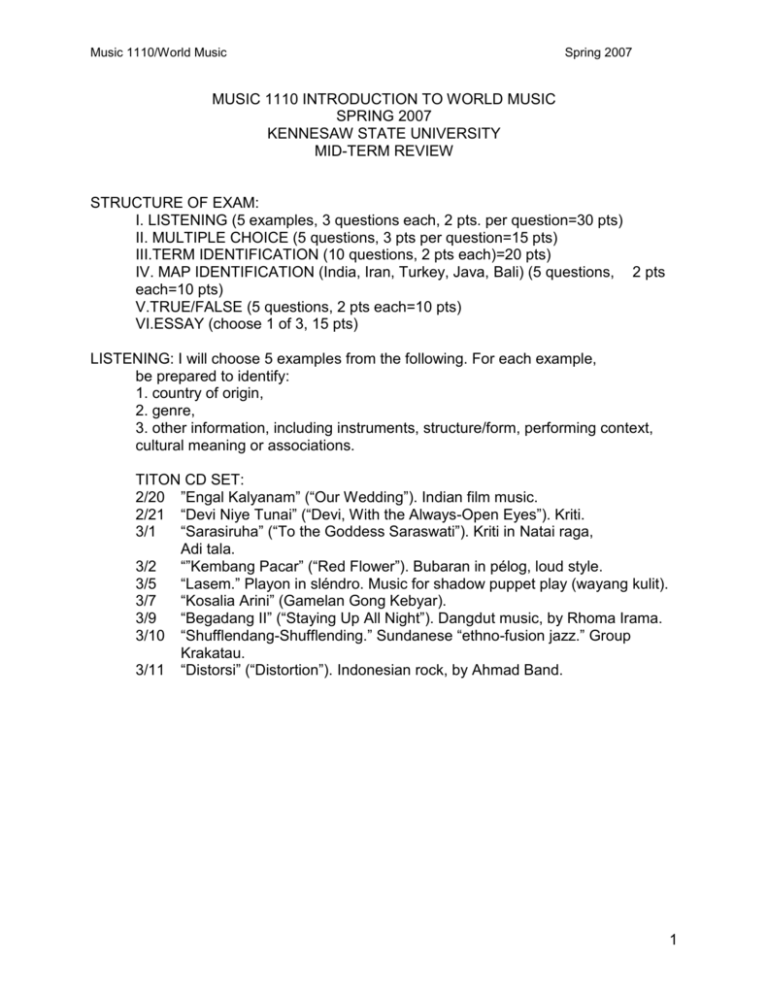music 1110 introduction to world music
advertisement

Music 1110/World Music Spring 2007 MUSIC 1110 INTRODUCTION TO WORLD MUSIC SPRING 2007 KENNESAW STATE UNIVERSITY MID-TERM REVIEW STRUCTURE OF EXAM: I. LISTENING (5 examples, 3 questions each, 2 pts. per question=30 pts) II. MULTIPLE CHOICE (5 questions, 3 pts per question=15 pts) III.TERM IDENTIFICATION (10 questions, 2 pts each)=20 pts) IV. MAP IDENTIFICATION (India, Iran, Turkey, Java, Bali) (5 questions, 2 pts each=10 pts) V.TRUE/FALSE (5 questions, 2 pts each=10 pts) VI.ESSAY (choose 1 of 3, 15 pts) LISTENING: I will choose 5 examples from the following. For each example, be prepared to identify: 1. country of origin, 2. genre, 3. other information, including instruments, structure/form, performing context, cultural meaning or associations. TITON CD SET: 2/20 ”Engal Kalyanam” (“Our Wedding”). Indian film music. 2/21 “Devi Niye Tunai” (“Devi, With the Always-Open Eyes”). Kriti. 3/1 “Sarasiruha” (“To the Goddess Saraswati”). Kriti in Natai raga, Adi tala. 3/2 “”Kembang Pacar” (“Red Flower”). Bubaran in pélog, loud style. 3/5 “Lasem.” Playon in sléndro. Music for shadow puppet play (wayang kulit). 3/7 “Kosalia Arini” (Gamelan Gong Kebyar). 3/9 “Begadang II” (“Staying Up All Night”). Dangdut music, by Rhoma Irama. 3/10 “Shufflendang-Shufflending.” Sundanese “ethno-fusion jazz.” Group Krakatau. 3/11 “Distorsi” (“Distortion”). Indonesian rock, by Ahmad Band. 1 Music 1110/World Music Spring 2007 TERMS: I will choose 10 terms from the following list for you to identify. Include country/culture when applicable. Carnatic kriti raga tala mridangam sitar dastgah radif avaz tar khandan usul Sufism Sema ritual Yogyakarta 2 Music 1110/World Music Spring 2007 slendro pelog colotomic structure wayang kulit MULTIPLE CHOICE AND TRUE/FALSE: Review the study questions on the Reading and Listening Assignment sheets for India and Indonesia. Review your notes for the Middle East. Sample questions: 1. Is music a universal “language”? What properties does language have that music does not (and vice versa)? Are there aspects of music that are universal? Give examples from class. 2. What is the difference between a “soundscape” and a “music culture”? Give some examples. Does one affect the other? 3. Describe Alan Merriam’s three-part model of music cultures. Give three examples of each of the three parts. 4. What are the sections of the kriti? What function do they have? Describe the use and function of improvisation in the kriti. 5. Describe typical performing forces for Indian classical music. What musical role does each play? 6. Describe the four groups of instruments in a gamelan in terms of function. 7. Describe the khandan-musiqi continuum and give some defining characteristics of each end of the spectrum. 8. Which music traditions were associated with court or royal patronage? Which are associated with religious practices or beliefs? 3 Music 1110/World Music Spring 2007 ESSAYS: You will choose one essay to write from 3 possible choices. Each essay should give at least ONE specific example of music heard in class to illustrate your points. Essays should be well-organized, and consist of at least three paragraphs (intro – body – conclusion). They should be 1 to 2 pages long (handwritten). Possible topics: 1. Compare and contrast the music-cultures of India with that of Iran. Be sure to address theory, beliefs about music, and the relationship between music and religion. 2. Compare and contrast Indian music theory with Persian music theory in terms of concepts of melody, rhythm, improvisation, musical form and transmission of the tradition. 3. Discuss the relationship between the music and the instruments of the Javanese gamelan and Javanese spiritual beliefs. In what ways are spiritual beliefs manifest in musical practice? 4. Discuss the sound-concept-behavior model as it applies to music-cultures, and apply it to a specific example discussed in class. What is the point of the model? How does it help us understand music as social behavior? 4








